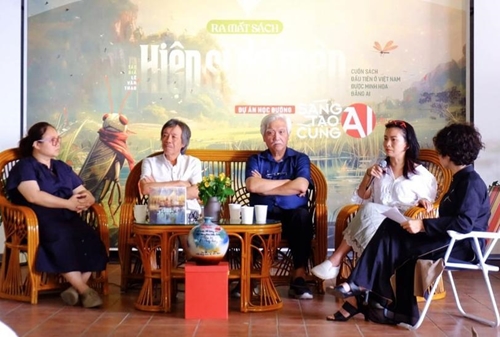Though the term "image industry" remains relatively new in the local context, the development of a creative ecosystem driven by AI will contribute to the advancement of Vietnam’s cultural industries.
AI - Trusted creative partner
In late May, the release of the illustrated novel “Hiep si De Men” (Knight Cricket) by author Le Van Thao marked a notable milestone in the use of AI in the arts. It became the first publication in Vietnam to be fully illustrated using AI, with over 200 artworks generated in collaboration with five specialized AI systems spanning character design, background composition, lighting, and post-production processing.
    |
 |
|
Delegates at the launching ceremony of the illustrated novel “Hiep si De Men” (Knight Cricket) |
For Thao, the project represents a deeply personal pursuit. Though the manuscript had been written more than 20 years ago, it was not until the advent of AI technology that he found the tools to fully realize his vision.
AI doesn’t replace the artist, but it opens a new door for creativity, said Thao, adding that it learns and grows to understand the artist’s intent.
Another notable project is the science-fiction film “Loi Nguyen Duoi Anh Trang” (Shadow of the Wolf), directed by emerging filmmaker Pham Vinh Khuong. Released in mid-June, the three-hour film was produced entirely using AI, without a physical studio or large production team, relying solely on a smartphone and a proprietary AI platform developed by the director himself. Before this, Khuong had attracted attention for AI-driven music videos such as “Cheo Mo Lai Ra,” “Buc Tranh Dai Viet,” “Mat Bao,” and “Tiec Trang.”
In the field of animation, the recent 3D theatrical release “Trang Quynh Nhi – Truyen Thuyet Kim Nguu” (Little Scholar Quynh: The Legend of Kim Nguu), produced by Alpha Animation Studio, showcases AI's capabilities in idea generation, narrative development, and visual design. According to Trinh Lam Tung, Meritorious Artist and director of the series, AI helps visualize imaginative worlds more quickly and streamlines repetitive tasks, allowing artists to focus more deeply on emotional expression and thematic messaging.
Catalyzing a breakthrough in the image industry
The integration of AI into the image industry brings numerous advantages, such as shortened production cycles, reduced costs, expanded creative possibilities, and a democratization of content creation. Independent creators and small teams can now produce high-quality works without requiring significant financial or human resources. Director Khuong observed that AI not only assists in scripting but also processes vast datasets to structure compelling narratives, enhancing creative autonomy and strategic storytelling.
Nevertheless, the role of AI in artistic creation continues to prompt reflection within the creative community. Tung emphasized that while AI can support early stages such as ideation and research, its application is limited when it comes to core artistic contributions.
AI cannot replicate the singular creative mindset of a director, screenwriter, or lead artist, said Tung. A film is more than moving images; it is a reflection of personal perspective and storytelling sensibility. AI cannot yet feel or narrate the way humans do, he noted.
Assoc. Prof., Dr. Do Lenh Hung Tu, Chairman of the Vietnam Cinema Association, echoed this sentiment, stressing that the essence of art lies in its emotional resonance, something AI cannot replicate. He suggested that for Vietnam’s cultural industries to thrive, including cinema and image production, it is vital not only to leverage technological tools like AI but also to ensure holistic investment in production, distribution, preservation, training, and the import-export of artistic works.
From another perspective, Thao highlighted how AI is reshaping creative thinking. In the realm of visual arts, where artists once had to sketch by hand daily, they now act as “creative directors,” defining vision and overseeing final outputs. “We are not losing our roles, we are being promoted. We become orchestrators of the creative process,” he remarked.
Recognizing the advantages of AI in artistic education, Thao and his collaborators have launched the school-based project “Creating with AI,” which introduces students to AI-assisted illustration, visual storytelling, and digital-age creativity. The initiative aims to promote responsible, effective use of AI in learning and creative expression.
As artists embrace technology, and as policy, infrastructure, and training continue to evolve, Vietnam’s image industry has the opportunity to produce culturally rich, globally resonant works. In this way, a sustainable and innovative future for the Vietnamese image industry is being charted in the digital era.
Source: VNA